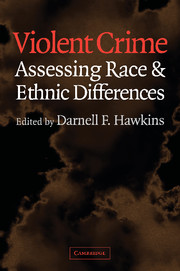Book contents
- Frontmatter
- Contents
- Contributors
- Foreword
- Editor's Introduction
- Violent Crime
- Part I Homicide Studies
- Part II Other Contexts, Settings, and Forms of Violence
- Part III Explaining Racial and Ethnic Differences
- 11 How Can the Relationship between Race and Violence be Explained?
- 12 “Race Effects” and Conceptual Ambiguity in Violence Research: Bringing Inequality Back In
- 13 The Violent Black Male: Conceptions of Race in Criminological Theories
- 14 The Structural-Cultural Perspective: A Theory of Black Male Violence
- 15 A Cultural Psychology Framework for the Study of African-American Morality and Violence
- 16 Racial Discrimination and Violence: A Longitudinal Perspective
- 17 Honor, Class, and White Southern Violence: A Historical Perspective
- References
- Index
12 - “Race Effects” and Conceptual Ambiguity in Violence Research: Bringing Inequality Back In
Published online by Cambridge University Press: 22 August 2009
- Frontmatter
- Contents
- Contributors
- Foreword
- Editor's Introduction
- Violent Crime
- Part I Homicide Studies
- Part II Other Contexts, Settings, and Forms of Violence
- Part III Explaining Racial and Ethnic Differences
- 11 How Can the Relationship between Race and Violence be Explained?
- 12 “Race Effects” and Conceptual Ambiguity in Violence Research: Bringing Inequality Back In
- 13 The Violent Black Male: Conceptions of Race in Criminological Theories
- 14 The Structural-Cultural Perspective: A Theory of Black Male Violence
- 15 A Cultural Psychology Framework for the Study of African-American Morality and Violence
- 16 Racial Discrimination and Violence: A Longitudinal Perspective
- 17 Honor, Class, and White Southern Violence: A Historical Perspective
- References
- Index
Summary
The United States is a dangerous place to live for racial/ethnic minority citizens. Research on this topic tends to deal primarily with the group with the highest level of violent activity, African Americans. However, recent research suggests that interpersonal violence represents a serious morbidity and mortality concern for other disadvantaged groups as well (Levine and Rosich, 1996). For instance, Martinez (1996) shows that urban Latinos have homicide rates that are considerably higher than the national average. Moreover, Yung and Hammond (1994) show that Native Americans also have violence rates that exceed their European counterparts. Typically, efforts to explain these higher levels of violence direct attention to group attributes or emphasize the social environment in which the group resides. While these approaches have generated some important findings, they are plagued by narrow conceptions of race and racial inequality and, thus, are limited in addressing disparate group patterns of violence.
In this chapter, we attempt to facilitate the reconceptualization process by first critically examining existing research and highlighting conceptual inadequacies. We then draw from stratification research and its explicit discussion of inequality and group outcomes to illustrate that the “effects” of race on violence are linked to very tangible macro-structural, normative, and interactional dynamics; ones sensitive to the local and historical dynamics associated with the social environment in which African Americans, and most race/ethnic minorities, tend to reside.
- Type
- Chapter
- Information
- Violent CrimeAssessing Race and Ethnic Differences, pp. 238 - 253Publisher: Cambridge University PressPrint publication year: 2003
- 4
- Cited by

